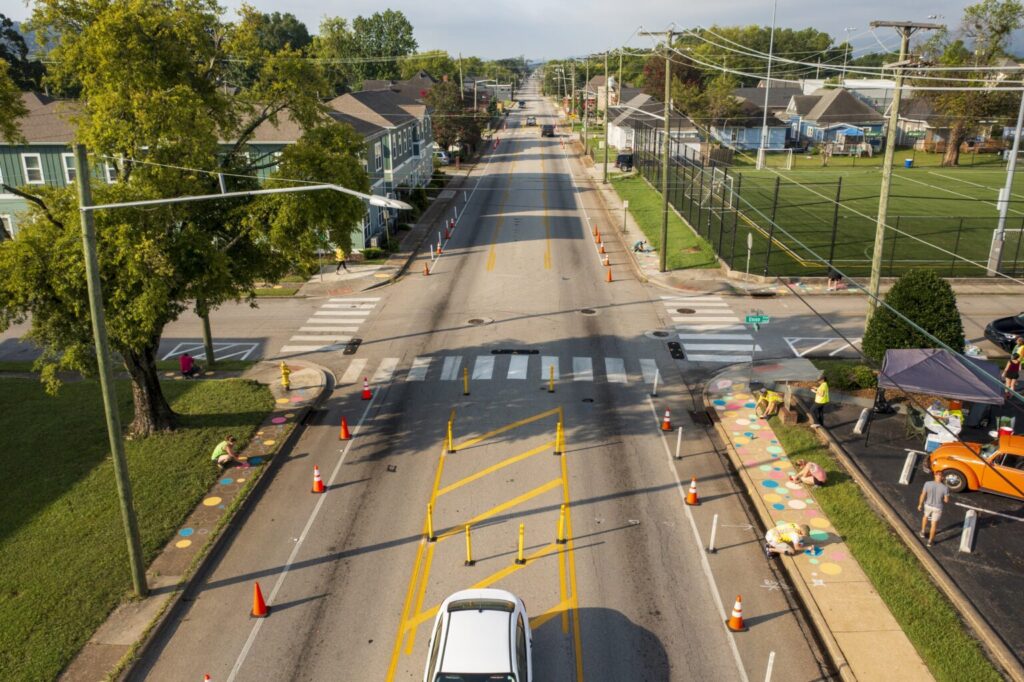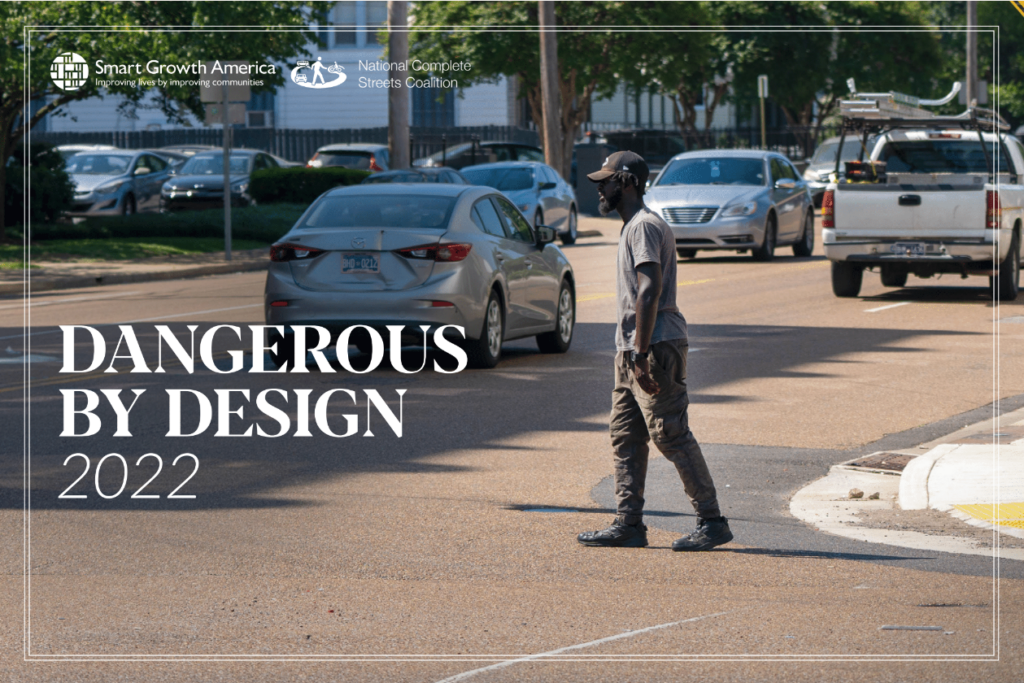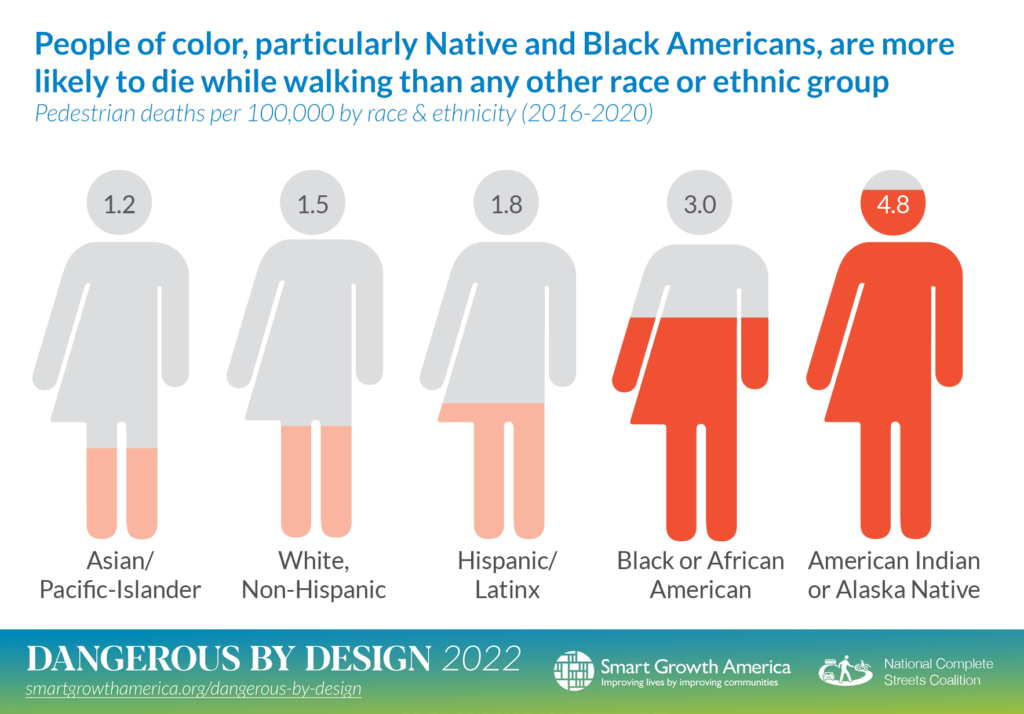
A decade of prioritizing speed over safety has led to 62 percent more deaths

Smart Growth America’s new report Dangerous by Design 2022 uses more data than ever to understand how design impacts travel behavior. The findings confirm what we’ve always known: it’s impossible to prioritize both safety and keeping cars moving quickly.

More than 6,500 people were struck and killed while walking in 2020, an average of nearly 18 per day, and a 4.5 percent increase over 2019. Today, our colleagues at Smart Growth America released their new report, Dangerous by Design 2022, to explain why. When streets are designed for vehicle speed as the top priority, pedestrians and other road users pay the price—often with their lives
And the burden isn’t shared equally. Low-income residents, older adults, and people of color are at greatest risk of being struck and killed while walking.

The Covid pandemic only heightened these issues. As driving decreased, congestion evaporated and speed increased, leading to more pedestrian deaths. Yet, at the same time, the pandemic unearthed a long-dormant demand for walking across the nation, and places with safer infrastructure saw fewer deaths.
The new Dangerous by Design report underscores the nationwide need and demand for safer streets. Read the report and join the public briefing on July 28th at 3 p.m. ET with the report authors and special guests to learn more about its findings. Register here.
This edition also includes guest supplements:
- The role engineering plays in dangerous design from Chuck Marohn of Strong Towns
- How to design for slower speeds and safety first from NACTO
- The safety impact of vehicle design from America Walks
- Why safer design is the most effective enforcement solution from Fines & Fees Justice Center
How can your community get safer?
Often, decision makers will claim that road safety is their top priority. In a recent hearing, Shawn Wilson of AASHTO said state DOTs and AASHTO are committed to doing everything they can to make roads safer. Representative Peter DeFazio asked an important follow-up question: if safety is the top priority, why are state DOTs transferring federal funds for safety (in this case, Highway Safety Improvement Program/HSIP dollars) away from safety projects?
That’s a great question from Rep. DeFazio, but we’d have a more pressing follow up: This claim that “safety is the top priority” has rung out from all states, even as pedestrian fatalities skyrocketed 62 percent up to historic highs since 2009. Why should we believe them any longer? These safety programs, while valuable, are tiny compared to the massive influx of cash into conventional road-building programs creating the safety problems in the first place. Here’s what we’d like to ask: why are we asking states to solve safety with tiny safety programs? Why isn’t our entire transportation program a safety program? How will we ever succeed using a million dollars to solve a problem being created every day by a billion?
This passage in the report (p. 28) gets to the heart of why we allocate historic amounts of money to infrastructure and only see the problem getting worse:
There are plenty of examples of successful safety improvements that have reduced fatalities on specific corridors within many of these largest 100 metro areas. But these metro areas have built 70 years of dangerous roads to retrofit, and these improvements, while welcome and needed, are the exception and not the rule. For this reason it has failed to lead to meaningful reductions in deaths across metro areas, states, and the nation. And at the same time states and cities are improving safety on specific corridors or intersections, many are building new roads with all of the same old issues. We need a transformation in the entire system—the task is monumental, and the effort needs to be sustained for years at the scale of this enormous problem.
Fatalities are increasing not because money from tiny programs like HSIP is being transferred out. It’s happening because we don’t make safety the top priority for every dollar spent. That’s why it’s one of our three key priorities.
If road design that prioritizes speed leads to more traffic fatalities, the opposite is also true. Designs that encourage slower speeds make all road users safer. Unfortunately, that’s not the status quo approach, and it’s hard to get our leaders to change their ways. The new infrastructure law could address street safety needs—if your state and local leaders are willing to make safety the priority. Learn about opportunities for safety funding on our blog.
Advocates can identify street safety needs and bring them to light. Read our recent blog on identifying infrastructure needs, even in the streets we’re most used to navigating. And visit this blog post for advice on keeping local decision makers accountable.
Dangerous by Design 2022 includes 5 key recommendations to make our streets safer. Read them in the new report.



